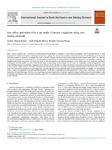Mostrar o rexistro simple do ítem
Size Effect and Other Effects on Mode I Fracture Toughness Using Two Testing Methods
| dc.contributor.author | Muñoz-Ibáñez, Andrea | |
| dc.contributor.author | Delgado Martín, Jordi | |
| dc.contributor.author | Juncosa, Ricardo | |
| dc.date.accessioned | 2021-08-25T08:37:40Z | |
| dc.date.available | 2021-08-25T08:37:40Z | |
| dc.date.issued | 2021 | |
| dc.identifier.citation | Muñoz-Ibáñez, A., Delgado-Martín, J., & Juncosa-Rivera, R. (2021). Size effect and other effects on mode I fracture toughness using two testing methods. International Journal of Rock Mechanics and Mining Sciences, 143, 104785. https://doi.org/10.1016/j.ijrmms.2021.104785. | es_ES |
| dc.identifier.issn | 1365-1609 | |
| dc.identifier.uri | http://hdl.handle.net/2183/28323 | |
| dc.description | Financiado para publicación en acceso aberto: Universidade da Coruña/CISUG | es_ES |
| dc.description.abstract | [Abstract] Mode I fracture toughness (KIC) is an intrinsic material property that quantifies its resistance to tensile fracture propagation. The International Society for Rock Mechanics has endorsed four methods to determine the KIC of rock, namely, the short rod, chevron bend, cracked chevron notched Brazilian disc, and semi-circular bend (SCB) methods. In this study, we compare the results of the SCB technique with those of the recently proposed pseudo-compact tension (pCT) test, which has proven to be convenient for the assessment of KIC in both fragile and ductile rocks. We select the SCB as a benchmark method due to its popularity, simplicity, and straightforward testing configuration. We discuss the results of 146 tests performed with different lithologies (Arcera, Pinacas and Corvio sandstones, and Blanco Mera granite), different sample sizes (100, 50 and 38 mm diameter), and a range of notch lengths. We also assess test repeatability and intercomparability of the results obtained using the two techniques. Compared with the SCB test, the pCT test allows for improved control of the specimen behaviour after the peak load, which provides a greater wealth of fracture mechanics information. pCT specimens yield results with higher repeatability than SCB samples. Although we observe that KIC tends to decrease with an increase in the notch length ratio, this effect appears to be non-significant based on statistical assessments. Accordingly, the corresponding mean KIC values are comparable for medium- and large specimens. The influence of specimen size is more pronounced in the SCB tests, while the pCT tests show less dependence for harder lithologies. Therefore, to set up minimum specimen requirements for fracture toughness testing, in addition to geometrical constraints, some key lithology-dependent properties (strength, mineralogy, grain size, etc.) should also be considered. Further methodological considerations related to test execution are also discussed. | es_ES |
| dc.description.sponsorship | This work was funded by Repsol S.A. and supported by the Xunta de Galicia, the European Union (European Social Fund - ESF) and the MINECO/AEI/FEDER EU project BIA2017-87066-R. Funding for open access charge: Universidade da Coruña/CISUG. | es_ES |
| dc.language.iso | eng | es_ES |
| dc.publisher | Elsevier | es_ES |
| dc.relation | info:eu-repo/grantAgreement/AEI/Plan Estatal de Investigación Científica y Técnica y de Innovación 2017-2020/BIA2017-87066-R/ES/ESTUDIO COMBINADO MEDIANTE TECNICAS PETROFISICAS Y EXPERIMENTALES DE PROCESOS TERMO-HIDRO-MECANO-QUIMICOS (THMC) ACOPLADOS A PARTIR ROCAS POROSAS SINTETICAS | |
| dc.relation.uri | https://doi.org/10.1016/j.ijrmms.2021.104785 | es_ES |
| dc.rights | Atribución 4.0 Internacional (CC BY 4.0) | es_ES |
| dc.rights.uri | https://creativecommons.org/licenses/by/4.0/ | * |
| dc.subject | Fracture toughness | es_ES |
| dc.subject | Fracture propagation | es_ES |
| dc.subject | Sandstones | es_ES |
| dc.subject | Fracture mechanics | es_ES |
| dc.subject | Mineralogy | es_ES |
| dc.title | Size Effect and Other Effects on Mode I Fracture Toughness Using Two Testing Methods | es_ES |
| dc.type | info:eu-repo/semantics/article | es_ES |
| dc.rights.access | info:eu-repo/semantics/openAccess | es_ES |
| UDC.journalTitle | International Journal of Rock Mechanics and Mining Sciences | es_ES |
| UDC.volume | 143 | es_ES |
| UDC.startPage | 104785 | es_ES |
| dc.identifier.doi | 10.1016/j.ijrmms.2021.104785 |






